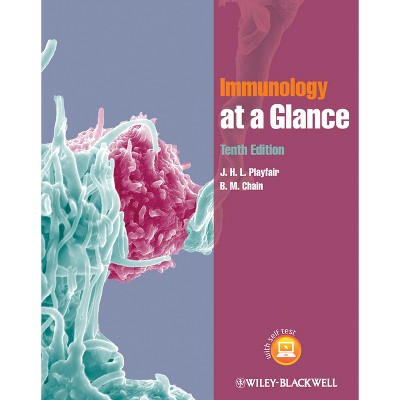Sponsored

Immunology - 2nd Edition by Klaus D Elgert (Hardcover)
In Stock
Sponsored
About this item
Highlights
- Blends biology, clinical science, genetics, and molecular biology of the immune system to provide a complete account of our knowledge of immunology New features include full-color artwork and design, over 50 new figures, and text that has been completely revised to reflect the very latest references Incorporates a variety of pedagogical aids to assist students in the learning process, including chapter outlines, objectives, and summaries, as well as a self-evaluation section
- About the Author: Klaus Elgert is Professor in the Department of Biological Sciences at Virginia Polytechnic Institute and State University in Blacksburg, Virginia.
- 744 Pages
- Medical, Immunology
Description
Book Synopsis
- Blends biology, clinical science, genetics, and molecular biology of the immune system to provide a complete account of our knowledge of immunology
- New features include full-color artwork and design, over 50 new figures, and text that has been completely revised to reflect the very latest references
- Incorporates a variety of pedagogical aids to assist students in the learning process, including chapter outlines, objectives, and summaries, as well as a self-evaluation section
From the Back Cover
A new edition of the comprehensive and accessible introduction to immunology
Immunology: Understanding the Immune System, Second Edition has been thoughtfully and meticulously updated to incorporate the many developments that have occurred in the field since publication of the previous edition. In addition to the consolidation, reconstruction, and revision of key material, features completely new to this edition include: three new chapters on innate immunity, immunodeficiencies, and immunity to microbes; more than fifty new figures; coverage of the latest knowledge on signaling pathways, lymphocyte trafficking, mucosal immunity, molecular mechanisms of receptor diversity, the T-lymphocyte immunological synapse, B-lymphocyte subsets, dendritic cell-driving of CD-4+ T-cell subset activities, biology of the CD-4+ T-cell TH17 subset and regulatory T-cell, cross-presentation, mechanisms of tolerance induction, immunoediting and tumor camouflage and the connection between inflammation and cancer development, immunogenetics of primary immunodeficiencies and the immunology of HIV infections and AIDS, and vaccines; and more--all immersed in full-color artwork, design, and user-friendly text.
This Second Edition provides a completely up-to-date introduction to immunology through its careful investigation of:
- Cells and organs of the human system
- Innate immunity
- Antigens and antibodies
- Antigen-antibody interactions and some experimental systems
- Genetics of antibody formation and structure
- The major histocompatibility complex and development of immunity
- T-cell receptor complex
- Cytokines
- Cellular interactions
- Hypersensitivities
- Immunologic tolerance and autoimmunity
- Transplantation immunology
- Tumor immunology
- Immunodeficiencies
- Immunity to microbes
Successfully blending biology, clinical science, genetics, and molecular biology, this book represents a complete account of our knowledge of immunology. It is complemented with a number of pedagogical aids that assist readers in the learning process, including chapter outlines, objectives, mini-summaries that provide "mental breathers" within the chapter to reassess the material just covered, full-chapter summaries, figures, and a self-evaluation section. The book ends with an extensive glossary and an appendix. It serves as an excellent textbook for courses in the life and medical sciences at the upper-undergraduate and graduate levels and as a reference for practicing scientists and clinical researchers.
About the Author
Klaus Elgert is Professor in the Department of Biological Sciences at Virginia Polytechnic Institute and State University in Blacksburg, Virginia. He has spent almost 32 years teaching immunology to undergraduate and graduate students and has won numerous teaching awards.
Shipping details
Return details
Trending Non-Fiction

















